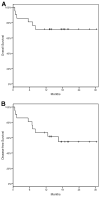Double unrelated reduced-intensity umbilical cord blood transplantation in adults
- PMID: 17222756
- PMCID: PMC2947324
- DOI: 10.1016/j.bbmt.2006.08.041
Double unrelated reduced-intensity umbilical cord blood transplantation in adults
Abstract
Umbilical cord blood (UBC) stem cells are a useful stem cell source for patients without matched related or unrelated donors. Adult transplantation with single UBC units is associated with high transplantation-related mortality (TRM). In most cases, mortality is due to infection related to slow engraftment and immunoincompetence. In this study, we used a reduced-intensity conditioning regimen of fludarabine, melphalan, and antithymocyte globulin followed by 2 partially matched UBC units. The UBC units were a 4/6 HLA match or better with each other and with the patient and achieved a minimum precryopreservation cell dose of 3.7 x 10(7) nucleated cells/kg. A total of 21 patients (median age, 49 years) were treated. The median time to an absolute neutrophil count > 0.5 x 10(9)/L was 20 days, and the median time to an unsupported platelet count > 20 x 10(9)/L was 41 days. Two patients experienced primary graft failure and underwent a second UBC transplantation. One patient had a late graft failure. Acute graft-versus-host disease (GVHD) grade II-IV occurred in 40% of patients. The 100-day TRM was 14%, and the 1-year disease-free survival was 67%. Mixed chimerism was associated with a higher risk of chronic GVHD. Our findings indicate that adult patients can tolerate double UBC transplantation well and achieve sustained antitumor responses using this reduced-intensity conditioning regimen.
Figures
References
-
- Kurtzberg J, Laughlin M, Graham ML, et al. Placental blood as a source of hematopoietic stem cells for transplantation into unrelated recipients. N Engl J Med. 1996;335:157–166. - PubMed
-
- Wagner JE, Barker JN, DeFor TE, et al. Transplantation of unrelated donor umbilical cord blood in 102 patients with malignant and nonmalignant diseases: influence of CD34 cell dose and HLA disparity on treatment-related mortality and survival. Blood. 2002;100:1611–1618. - PubMed
-
- Michel G, Rocha V, Chevret S, et al. Unrelated cord blood transplantation for childhood acute myeloid leukemia: a Eurocord Group analysis. Blood. 2003;102:4290–4297. - PubMed
-
- Ballen KK. New trends in umbilical cord blood transplantation. Blood. 2005;105:3786–3792. - PubMed
Publication types
MeSH terms
Substances
Grants and funding
LinkOut - more resources
Full Text Sources
Medical
Research Materials



